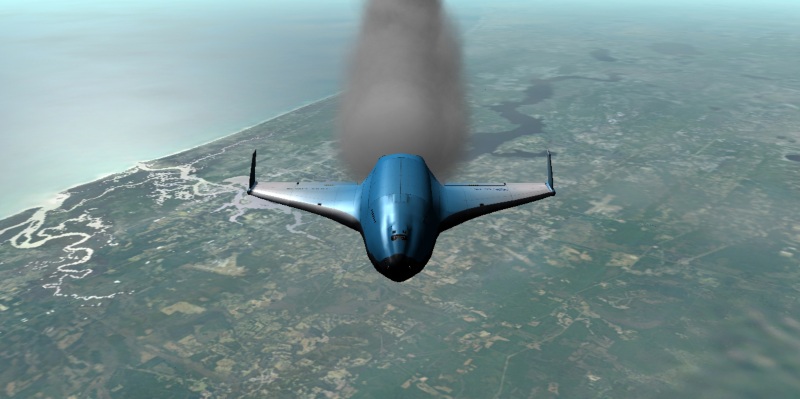Difference between revisions of "XR-5 Vanguard"
m (Spelling) |
|||
| Line 34: | Line 34: | ||
* EVA and crew support using UMmu by DanSteph. | * EVA and crew support using UMmu by DanSteph. | ||
* High-polygon UMMU astronaut meshes developed by Greg Burch and used with permission. Also compatible with any other spacesuit mesh available for UMMU. | * High-polygon UMMU astronaut meshes developed by Greg Burch and used with permission. Also compatible with any other spacesuit mesh available for UMMU. | ||
| + | |||
| + | {{HasPrecis}} | ||
[[Category:Add-ons]] | [[Category:Add-ons]] | ||
Revision as of 00:31, 31 October 2012
The XR-5 Vanguard is a high-performance Spacecraft created for Orbiter by the Altea Aerospace team. The XR5's mesh was designed by Russel Hicks, texturing work done by PennyBlack, and payloads designed by Carmen A & Tom Fisher. Coding work to add multiple subsystems, failure modes, UMMU support, and Payload Management was done by Douglas Beachy, as with other vessels in the XR series. The initial 1.0c release came on April 20, 2008, and the most recent release was 1.8 on May 13, 2012.
Design Concept
The XR5 was designed as a single stage to orbit, reusable spaceplane able to carry up to 18 passengers and up to 432 metric tonnes of cargo to low Earth orbit. The exact design parameters for the XR5 are variable, depending on the preferences set by a user in the configuration file, but with realism settings set to their highest levels, the XR5 proves a difficult vessel to fly successfully. Like the rest of the XR fleet, scramjet engines are typically used during the bulk of the ascent to orbit, providing orbital velocity in the high atmosphere before conventional rocket engines are used to provide the final orbital insertion above the altitude where the scramjet engines are effective.
Features
Current features of the XR5 include:
- A 2D instrument panel with native support for 1280-, 1600-, and 1920-pixel-wide video modes, set by the 2DPanelWidth parameter in the Config\XR5VanguardPrefs.cfg file.
- All-new instrument panels at native 1280x1024, 1600x1200, or 1920x1200 resolutions with 24-bit color. The main panel is low-profile in the center for maximum visibility.
- Realistic simulation of atmospheric reentry heating, hull breaches typically occurring after 8 seconds of reentry heat over maximums.
- Realistic simulation of Scramjet engine overheating and related damage.
- [CHEATCODES] support in the XR5VanguardPrefs.cfg file that allowing users to directly set certain values such as the ship's mass, maximum engine thrust, fuel tank capacity, etc.
- Multi-Display-Area (MDA) touch screen on the main instrument panel with multiple modes for custom autopilots, hull temperatures, ship damage status, and other ships functions. Readouts are switchable between degrees Celsius, Kelvin, and Fahrenheit by clicking an area on the MDA screen.
- Efficient Attitude Hold autopilot available to hold a given pitch/AOA and bank while minimizing yaw; typically used during reentry or to hold attitude while braking with hover engines in a vacuum. Autopilot can hold a stable reentry at 10x time acceleration and can operate at 100x in space.
- Efficient Descent Hold and Auto-Land autopilot able to hold a descent or ascent rate. Autopilot can auto-land with a frame rate of around 100 fps, at 80x time acceleration and can operate at 100x in space. This means that users can auto-land the XR5 even with an effective frame rate of only 1.25 frames per second, and can hold a set ascent/descent rate with an effective frame rate of only one frame per second.
- Airspeed Hold autopilot able to effectively hold a given airspeed within 0.1 meters-per-second.
- Reentry Systems Check MDA mode allows users to verify that the ship is properly configured for reentry.
- A new pop-up data HUD listing all the new XR5 keyboard shortcut keys.
- Extensive damage and warning modeling including wing load limits, dynamic pressure and heat limits for different surfaces, and gear collapse on landing. Crew may be injured or killed by hard landings or crashes, although the XR5's landing gear are compressible.
- Callouts for altitude, speed, damage, warning, system failure, and docking distances.
- Auxiliary Power Unit (APU) with limited fuel that is used to power hydraulic systems such as aerodynamic control surfaces, landing gear, and wheel brakes.
- APU and O2 consumables management with ship's mass being affected by LOX (Liquid Oxygen) and APU fuel masses in addition to other propellants and any crew members.
- Internal system coolant management. Heating internal coolants beyond their limits will cause internal systems failure.
- Two pop-up mini-Heads up displays. Secondary HUDs are fully configurable, showing flight data such as altitude, airspeed, and orbital elements in Metric and Imperial units. Tertiary HUD is used to show ship's status, damage, and warnings.
- Redesigned SCRAM (Supersonic RAMJET) engines capable of operation up to around Mach 18.
- Sound effects and voice callouts requiring OrbiterSound 3.5 by DanSteph.
- Self-starting Mission-Elapsed-Time (MET) timer plus two manual interval timers.
- Refueling and LOX resupply/dump support.
- Capable of fuel cross-feed between main and RCS tanks.
- Scenario editor support.
- EVA and crew support using UMmu by DanSteph.
- High-polygon UMMU astronaut meshes developed by Greg Burch and used with permission. Also compatible with any other spacesuit mesh available for UMMU.
Precis
This article has a precis and appears in the Random addon or Random article section on the Main Page. The precis can be found at XR-5 Vanguard/precis and is displayed below.
|
The XR-5 Vanguard is a high-performance Spacecraft created for Orbiter by the Altea Aerospace team. The XR5's mesh was designed by Russel Hicks, texturing work done by PennyBlack, and payloads designed by Carmen A & Tom Fisher. Coding work to add multiple subsystems, failure modes and Payload Management is done by Douglas Beachy, as with other vessels in the XR series. The initial 1.0c release came on April 20, 2008, and the most recent release was 1.13 on February 20, 2018. (More...) |

